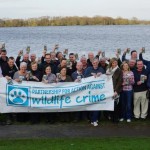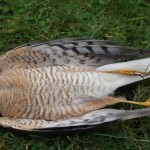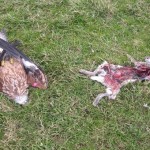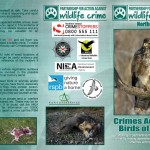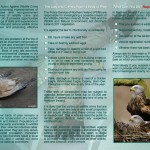Uncategorized
Buzzard Cam Launched in Co. Down – interactive monitoring of buzzard nests by Northern Ireland Raptor Study Group at National Trust property Mount Stewart, on the Ards Peninsula.
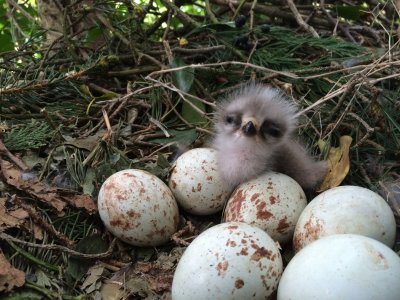 The Northern Ireland Raptor Study Group (NIRSG) in collaboration with the National Trust has this year embarked on an initiative to remotely monitor activity at buzzard nests and facilitate a unique raptor interactive experience with the wider public.
The Northern Ireland Raptor Study Group (NIRSG) in collaboration with the National Trust has this year embarked on an initiative to remotely monitor activity at buzzard nests and facilitate a unique raptor interactive experience with the wider public.
Teams of raptor study group volunteers have been closely monitoring all raptors across Northern Ireland but two special buzzard nests on Mount Stewart estate on the Ards peninsula have been getting close attention over recent weeks, one of which contained three eggs and the second contained an exceptional six eggs and one recently hatched chick, meaning that seven eggs were laid.
These two buzzard nests are currently being monitored for research purposes by remote cameras, under special licences and permits from the Northern Ireland Environment Agency (NIEA) and Forest Service NI, at the stunning National Trust property at Mount Stewart, Co. Down.
Footage from one of these nests which had the three eggs is being streamed to the wider public via the NIRSG web-page (www.nirsg.com) and footage is also being relayed to TV screens at Mount Stewart where people can also watch the progress of the nest over the summer.
Dr Marc Ruddock, Project Manager for the NIRSG said; “We were hugely grateful to have received funding from the Challenge Fund in 2015 to visit schools across Northern Ireland and also to build this remote monitoring camera system. This system took many months to build and we now have a remotely powered camera recording high quality footage of the buzzard nests in Mount Stewart. Dr Ruddock continued “We would like to thank Andrew Murray and Stuart Ogg, the experts behind the construction of the system and also the National Trust for hosting the camera and our Raptor Officer for working to locate these nests. Dr Ruddock concluded this team project provides a fantastic blend of wildlife knowledge, raptor understanding, technology, field survey effort and with the essential support of land managers to provide a truly unique interactive experience for our raptor workers and also the public”.
Mr Andrew Upton, Coast and Countryside Manager for National Trust for Strangford Lough & the Ards Peninsula said “We are delighted to have been able to host this type of project at one of our properties and we will have footage from the camera system relayed to screens at Mount Stewart to allow our visitors to see what happens first hand in the buzzard nest and we look forward to people coming to see this species on the estate in such a novel and interactive way whilst causing no disturbance to these special birds”.
Dr Eimear Rooney, the NIRSG Raptor Officer, who completed her PhD on buzzards in Northern Ireland said “I am excited to be able to get a 24/7 insight into the life of a buzzard family. This is a species which is far too often killed illegally in Northern Ireland, particularly by poisoning, and this type of research and engagement with people is really important for us all to understand the value of raptors (birds of prey) and their behaviour and lifestyles within our eco-system”. Dr Rooney continued “Our volunteers work tirelessly in monitoring many birds of prey across Northern Ireland and we wouldn’t find interesting nests such as this without the hard work of the volunteers. If anyone would like to help you can report your raptor sightings at the NIRSG webpage or why not follow us via Facebook to get updates about our work and in particular to receive updates of these nests”.
Carol Forster from Northern Ireland Environment Link (NIEL) which administered the Challenge Fund monies for the camera and education projects to the NIRSG said “It’s really wonderful to see Challenge Fund money used for such a positive project delivering clear multiple benefits – benefits for wildlife, benefits for society in getting volunteers involved in nature, and benefits for government in terms of monitoring and data gathering”.
Cathy Smyth ornithologist at Northern Ireland Environment Agency said “NIEA is delighted to work closely with the NIRSG and this interactive project, giving visitors a chance to get up close to a buzzard nest and affording them the opportunity to develop an interest in these fantastic birds”.
Press Release – Raptor Crime Leaflet Launched
8th March 2014
On the 8th March, at the annual Northern Ireland Raptor Study Group conference at Oxford Island Nature Reserve a new bird of prey (raptor) leaflet was launched by the Partnership for Action Against Wildlife Crime (PAW) Northern Ireland encouraging members of the public to record and report suspected cases of raptor crime directly to the Police Service of Northern Ireland (PSNI).
In living memory during the 1960s, Northern Ireland lost our last breeding golden eagles, at Fairhead in Co. Antrim. It is believed persecution, habitat loss, negative human attitudes and disturbance all played a key part in the loss of some of our breeding raptor species over the past 200 years. Amongst others we lost breeding golden eagles, white-tailed eagles, ospreys and red kites whilst buzzards were almost totally extinct.
Over time some of these species have recovered naturally or via re-introduction programmes and are hailed as conservation successes. However, each year illegal incidents of shooting or poisoning are recorded and undoubtedly the incidents detected may only be the tip of the iceberg.
Dr Eimear Rooney, recently appointed as Raptor Officer, with NIRSG, stated: “Disappointingly our volunteers detect incidents of raptor crime each year, particularly of peregrines falcons and buzzards being poisoned or shot. Some of our rarer species, such as the hen harrier, are still threatened by habitat destruction with several known nest sites having been burnt out during uncontrolled heather fires in recent years. It is important that our volunteers and the wider public learn how to detect and report raptor crimes so we can minimise the effects of illegal activities on their populations”.
Dr Jon Lees, NIEA Wildlife Officer said, “PAW NI aims to increase public awareness of crimes against our wildlife, to increase reporting of suspected wildlife crimes to the PSNI and to deter offenders in the first place. The loss of primary predators such as birds of prey from our ecosystems has serious consequences for Northern Ireland’s ecosystem, which ultimately impact a wide range of species. The barbaric and cruel methods used by the offenders to trap, poison or kill these birds would offend the majority of Northern Ireland’s citizens and these criminals can often put human lives at risk by indiscriminate use of highly toxic chemicals. The PAW NI appeal to the wider public to report these types of crimes, as they would any other crime, to help the PSNI tackle these issues. Raptor crime, or indeed any wildlife crime, simply should not be tolerated”.
Wildlife Officer for the Police Service of Northern Ireland, Emma Meredith said: “Wildlife crime incidents, particularly where they occur in remote locations, can often go unreported. I hope the information leaflet will continue to encourage members of the public to provide valuable information to the police, and help us continue to build a more accurate picture of the extent of raptor crime on our native birds in a tangible way”.
Emma, continued; “It does not matter how small each piece of information that members of the public have, it could help the PSNI protect our raptor species. I would urge people to pass this information either directly to Police on 101 or anonymously to Crimestoppers on 0800 555 111”.
“The PSNI have welcomed the stream of wildlife crime initiatives emanating from the Partnership for Action against Wildlife Crime sub-groups including deer poaching, fish poaching and now raptor crimes; the collective agreement and support by all these groups, representing such a diverse range of outdoor activities, hobbies and sports, is humbling to see in action as we are united against wildlife crime”
Often raptors in Northern Ireland are poisoned by highly toxic, illegally used substances such as carbofuran or alphachloralose, which are laid out on meat baits, such as dead rabbits or even sausages, in the open countryside. These baits are typically left uncovered and can easily be discovered not only by wildlife but also children or be eaten by pet dogs or cats with fatal consequences. Numerous incidents of pets being poisoned are also recorded every year in Northern Ireland. These types of activities should not be tolerated and present a serious risk to human health and the perpetrators simply do not seem to have a conscience in this regard.
Bob Elliot and Adam McClure, with RSPB, both reinforced this message and they stated: “This issue is of critical importance to our native raptors and notably to the re-introduced red kite population. Over the last 12 months we have lost four red kites to illegal poisoning including the deaths of adult birds but also red kite chicks still at the nest. We must deploy every available tool in the ongoing fight against wildlife crime and it’s vital that everyone is encouraged to report these crimes to the police.”
This leaflet is aimed to disseminate information, and particularly improve awareness, detection and reporting of raptor crime throughout Northern Ireland. Crime prevention through education and awareness raising plays a vital role in reducing criminality and anyone with information on raptor crimes are urged to contact their local PSNI.
- Photo of the leaflet launch on 8th March, with delegates at the annual raptor conference, Oxford Island, Lough Neagh
- Dead sparrowhawk
- Dead Northern Ireland Red Kite and baited rabbit
- Leaflet Page 1
- Leaflet Page 2
